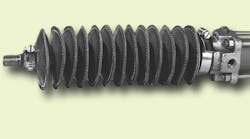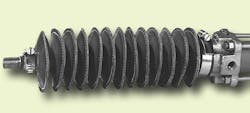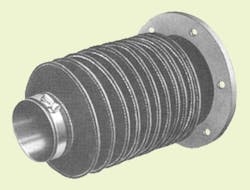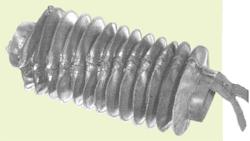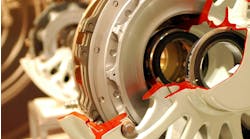When dirt, grit, metal chips, scale, and other substances impinge on exposed hydraulic or pneumatic cylinder rods, these contaminants not only shorten the life of the seals, but often can damage the rods themselves. For almost all applications where contaminant-caused wear is a problem, installing the proper protective rod boot can make a big difference in rod and seal life. One manufacturer of automated welding equipment — which was exposed constantly to hot weld spatter — noticed a decline in service problems and achieved longer service life after the hydraulic cylinders were fitted with bellows-type boots fabricated from Hypalon-coated polyester material.
Although simple conical-shaped boots are sometimes used to protect short-stroke cylinder rods, a round bellows made by one of several construction methods is generally the most suitable design. Bellows originally were made by sewing discs of leather or rubberized fabric together. The outer circumference of one disc was sewn to the outer circumference of a second disc. The inner circumference of this second disc was then sewn to the inner circumference of a third disc. The outer circumference of the third disc, in turn, was sewn to the outer circumference of a fourth disc. This alternating pattern continued until the required length was attained. This process is still widely used today, but other methods of attachment in addition to sewing are often used. Today’s suppliers can furnish a wide variety of configurations and materials to protect cylinder rods and seals from most types of contaminants.
Selecting the Right Boot
The selection process, of course, requires weighing the interrelated design and operating parameters to pick the best solution for the application at hand. The following variables should be considered:
● space available for the boot in both retracted and extended positions
● cross-sectional area available
● possible interference points along extended length
● stroke length
● rate of travel and cycle frequency
● ambient and operating temperatures
● type, source, and amount of contaminants
● possible need for venting because of high travel speeds, and
● need to accommodate a non-linear travel path because of unusual mounting situations or operation in conjunction with other mechanisms.
Despite all these variables, standard rod boots are available to handle most common protective requirements, and custom boots can be developed for more complex situations, usually with little or no tooling charge.
Different boot constructions offer different extended-to-retracted (E/R) length ratios. In general, as boot OD increases while holding boot ID constant, the extended-to-retracted ratio increases. If radial clearance is limited around the cylinder rod, the boot may have too long a retracted length due to OD limitations. To overcome this, the boot can be mounted over the cap end of the cylinder so it encompasses the entire cylinder. This essentially doubles the retracted length, which effectively cuts the required E/R ratio in half to allow a smaller OD for a given ID. For rodless cylinders, the entire cylinder usually is enclosed by the boot.
Boot Construction and Design
Standard stitched-construction boots, Figure 1, protect internal components from damage by common contaminants and nominally severe environments. Assembled from rings of elastomer-coated fabric sewn along alternating inner and outer circumferences, these boots will exclude most dust, dirt, chips and coolants. For added sealing or abrasion protection, seams can be coated after stitching. This construction offers the widest choice of materials for all types of service requirements and allows the greatest E/R length ratios. End collars or flanges for mounting can be any size or shape, whether larger or smaller than the boot.
Stitched bellows cannot be completely sealed, so adherence to air-, light-, or dust-tight requirements cannot be guaranteed. Coating helps, but a sewn boot still tends to “breathe” through its seams. For areas where fine contaminants require more complete exclusion, it may be necessary to seal the boot so tightly that it may collapse if the travel speed is too rapid. Realize that the boot is actually a bellows, so a vacuum is generated during rod extension, and internal pressure develops during retraction if adequate venting is not provided. Methods will be described for providing the necessary makeup air while still excluding contaminants.
For more complete sealing and improved appearance, a vulcanized bellows of Hypalon-coated polyester material can be used. These are similar to the stitched bellows, except that seams are vulcanized instead of stitched, making them air-, light- and dust-tight. Because these seams are wider, the E/R ratio is slightly lower than with standard stitched construction. This factor becomes critical primarily if space for the boot is limited when the cylinder rod is retracted.
Injection-molded bellows configurations offer complete sealing but present some disadvantages. Molds are expensive, so volume requirements for cost effectiveness may be too high for most applications. Because the material is not reinforced, it lacks strength and can tear; and the rounded convolution shapes usually exhibit a poor E/R ratio. In most cases, a suitable custom boot can be produced by other processes using standard tooling and components.
An excellent alternative is a bellows- type cover expanded from a tube of fabric-reinforced elastomer. It provides the same tight-sealing advantages of a molded boot, but with additional strength and low tooling charges, if any. These boots are cured or vulcanized after forming and can be made with a variety of end mounting configurations. Ranges of E/R ratios and stroke-to-retracted- length (S/R) ratios for the various designs and material thicknesses are available from manufacturers.
Materials and Mounting
Many different materials can be used to produce rod boots, depending on the operating conditions and the manufacturing process selected to meet the needs of the application. Base fabrics include nylon, fiberglass, and Kevlar. Elastomers commonly used for boots include butyl, nitrile, neoprene, silicone, synthetic rubber, fluoroelastomer, PTFE, and polyurethane. Other specialized materials also are available, such as aluminized fiberglass for welding applications.
Even though the potential damage caused by abrasive debris is a legitimate design concern, fabric-reinforced elastomer materials used in these covers will withstand a fair amount of abuse. When conditions are extreme, such as very sharp or hot particles, even more durable materials can be specified, such as Hypalon for greater abrasion resistance than neoprene. Other types of contamination could require different engineering approaches. Covers for food processing machinery, as a case in point, generally use special material that will not contaminate and can withstand frequent washdowns. A formed or molded construction usually is used to provide smoother contours than a stitched bellows.
Two basic methods are used for mounting most rod boots; ends are held in place either by a collar and hose clamp or by a flange and backing plate. Most often, a hose clamp fastens a collar on one end of the boot to the rod end or clevis. At the other end, a flange at the end of the boot may be bolted to the face of the cylinder with a large washer-type backup plate that has appropriate mounting holes, Figure 2. The boot also can be furnished with a collar, sized to fit the cylinder body or a boss, if it is long enough, and fastened in place with a hose clamp.
Certain characteristics can be added to most boot designs. In addition to flanged or collared ends for mounting, typical accessories include screen vents or breathers and tie strips or tapes to ensure uniform extension. Longitudinal zippers, Figure 3, accommodate retrofit installations where disassembly would be difficult or impractical. This longitudinal slit also allows access to internal components for inspection, relubrication, adjustment, etc.
Application Considerations
When considering the various rod boot choices and the specifics of your application, don’t overlook the little details that can make the difference between effective protection and consternation. Many times, what would be a troublesome condition can be accommodated with one of the optional designs available from the manufacturer.
For example, installing several screen breathers may allow sufficient venting for applications if contaminants are course enough. Finer contamination may require a breather hose routed to a filter or a cleaner intake location.
Potential interference throughout the length of the proposed boot’s travel is often overlooked. Methods of accommodating some obstructions include extra-long mounting collars or special flanges. Thoroughly checking and documenting any obstructions will enable the manufacturer to suggest the most effective way of handling them.
A concern that usually can be neglected is the load imposed on a system by the boot. Negligible force is needed to operate most rod boots through the cylinder stroke when compared to the high cylinder forces generated in most fluid power applications. In other than the most sensitive laboratory equipment, load from the boot can be neglected.
